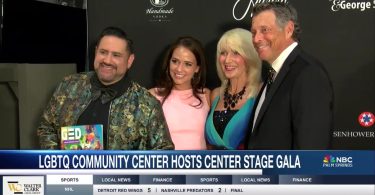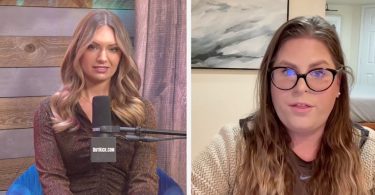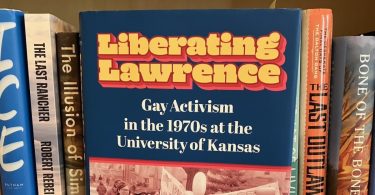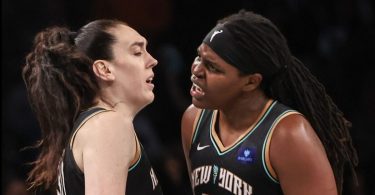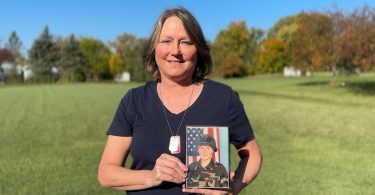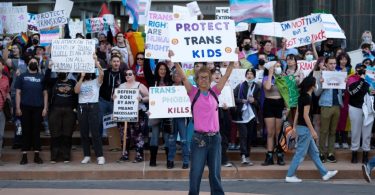Councilmember Hugo Soto-Martínez applauds as community member Donovan Daughtry and
Councilmember Nithya Raman remove the “No U Turn” sign on Griffith Park Blvd. in Silver Lake on Monday, June 10, 2024. LGBTQ+ organizations, and community leaders made remarks about LGBTQ+ history in Los Angeles, before removing the remaining “No U-Turn” signs put up along with “No Cruising” signs to target and persecute the LGBTQ+ community in Silver Lake in the 1990s. (Photo by Dean Musgrove, Los Angeles Daily News/SCNG)
About 27 years after “No U-turn” signs were posted along Griffith Park Boulevard in Silver Lake in an attempt to keep gay men from cruising the neighborhood to pick up other gay men, members and allies of the LGBTQ+ community joined two Los Angeles city councilmembers on Monday, June 10, as they took down the last two remaining “No U-turn” signs that were put up in the 1990s.
The removal of the signs took place at Griffith Park Boulevard and Fernwood Avenue, which straddles Los Angeles City Council Districts 4 and 13.
Getting rid of the signs was long overdue for many, including Donovan Daughtry, a gay man who five years ago moved to Silver Lake, known as being LGBTQ-friendly.
Two years ago, Daughtry reached out to L.A. City Councilmember Nithya Raman’s office about the signs after learning about them from a podcast hosted by Chris Cruse, founder of queermaps.org, an online archive of 150 years of queer history in L.A. On Monday, moments after he helped take down the last sign, Daughtry said, “This is a small effort, but just to have a sign that I would have to walk past with my dog every day be taken down meant a lot.”
Before the signs came down, city elected officials and community members gathered nearby at the AT Center, a recovery and wellness center for the LGBTQ+ community, to mark the occasion with speeches and performances.
The AT Center is less than half a mile from The Black Cat, a famous tavern on Sunset Boulevard that was the site of a 1967 demonstration after police raided the gay bar. That demonstration preceded the 1969 Stonewall Inn uprising in New York City and was, at the time, the largest pro-LGBTQ+ demonstration in the nation.
City Councilmember Hugo Soto-Martínez represents Council District 13 where one of the signs was removed Monday. Given Silver Lake’s history of supporting the LGBTQ+ community, one might not think that signs meant to stop gay men from meeting would appear in this community, he said.
“It’s just another example of what (LGBTQ+) folks continue to face, and especially what they were facing in that particular time,” Soto-Martínez said.
Citing hateful transphobic attacks reported across the country, he said, “I think it’s good that we’re finding the areas and the symbols within our own city that … have these hateful remnants of the past” and to address them.
Councilmember Raman, who represents Council District 4 where the other sign was removed, described Los Angeles as a city that has led the fight for justice in many ways, but where resistance to change also “has inscribed itself on our physical spaces in so many different ways.”
“And now we get to do the work of taking it apart, piece by piece, and building an even better city going forward,” Raman said.
“We come here today in joy and in love,” she said.
In 1997, “No U-turn” and “No Cruising” signs went up around Silver Lake to stop members of the LGBTQ+ community from cruising in the area. Citing a 2011 article by The Eastsider, Hugo-Martínez’s office said “cruising” in that context was a euphemism for “searching for sex partners.”
The “No Cruising” and “No U-turn” signs allowed law enforcement to arrest any driver who did a U-turn on Griffith Park Boulevard between midnight and 6 a.m. or who drove down the street more than once within a six-hour period.
At the time, members of the gay community claimed that undercover police deliberately lured men they suspected of being gay in order to arrest them.
In 2011, the city removed the “No Cruising” signs in response to local activism and advocacy from the Silver Lake Neighborhood Council. But nine “No U-turn” signs remained up along Griffith Park Boulevard until Monday when the last signs were taken down.
Those who attended Monday’s ceremony were treated to performances by West Hollywood Drag Laureate and singer “Pickle,” as well as violinist “Queen Angelina.”
The group then walked up the street to the corner of Griffith Park Boulevard and Fernwood Avenue, where the two last signs stood on opposite sides of Griffith Park Boulevard.
The crowd broke into cheers and applause after the first sign came down. One person said, “(There’s) no going back to being straight,” prompting laughter from the crowd.
Among those at Monday’s event was Maebe A. Girl, a Silver Lake Neighborhood council member who made history in 2019 as the first drag queen to be elected to office in the country. Her work on the neighborhood council has included efforts to get anti-LGBTQ+ signs removed.
“As a queer person myself, I didn’t feel comfortable having these relics of the past still lingering in our neighborhood, as did everyone else that I’ve spoken with,” she said. “I don’t think anybody wants to keep these relics of the past that essentially were designed to profile gay people.”
A spokesperson for Soto-Martínez said the city hasn’t decided what to do with the signs that were removed this week, but at least one may be donated to the ONE National Gay & Lesbian Archives at the University of Southern California.
Related Articles
As mpox cases rise, experts urge complete, 2-part vaccinations
Thousands celebrate ‘Power in Pride’ at 54th annual LA Pride Parade
LA celebrates “Pride in the Park,” marking diverse LGBTQ history
Queer activists trying to ramp up Palestinian support at Pride events
Los Angeles City Hall flies Progress Pride Flag to celebrate LGBTQ+ community


